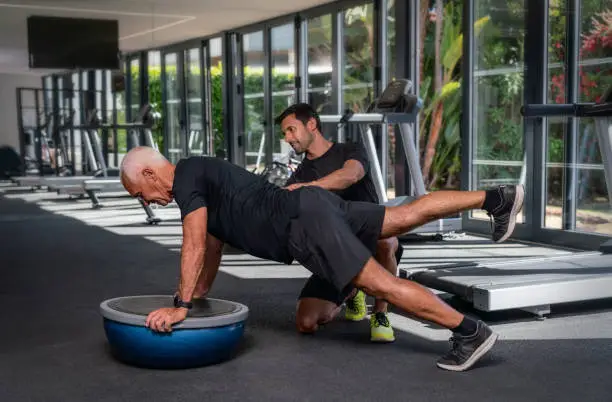We envision a world where everyone has the tools and knowledge to live a balanced, healthy, and fulfilling life. By providing reliable resources, personalized programs, and community support, we aim to be a beacon of hope for those on their health journey.
Table of Contents
Introduction: The Dilemma of Weight Loss Methods

Hers Weight Loss
In the journey towards effective weight loss, individuals often grapple with choosing the right fitness regimen. The ongoing debate surrounding resistance training and cardio has gained significant attention, as both methods promise various health benefits and weight management results. Understanding the nuances between these two approaches is crucial for anyone looking to achieve their fitness goals.
Cardiovascular exercise, commonly known as cardio, is an activity that prominently elevates the heart rate. It encompasses activities like running, cycling, and swimming, contributing to calorie expenditure and improved cardiovascular health. learn: How to Become Fit Without Gym: Small Changes1 Big Results!;
On the other hand, resistance training, which includes weight lifting and bodyweight exercises, focuses on building muscle mass and strength. Each method holds its distinct advantages and challenges that can impact an individual’s weight loss journey.
One of the primary benefits of cardio is its ability to promote significant caloric burn during workouts, effectively aiding in creating a calorie deficit, which is essential for weight loss. However, prolonged cardio sessions can sometimes lead to muscle loss if not adequately complemented with strength training. In contrast, resistance training enhances lean muscle, which is a key player in boosting metabolism and fostering sustained weight loss. Yet, it may not burn as many calories during the session compared to cardio.
Ultimately, the choice between resistance training and cardio depends on individual preferences, fitness levels, and specific weight loss objectives. Recognizing that both methods have their inherent strengths, a balanced approach that incorporates elements of each could yield optimal health benefits. Establishing a comprehensive fitness routine can not only support weight management but also promote overall well-being. The exploration of these two methodologies is essential to understanding their roles in effective weight loss strategies.
Understanding Weight Loss: The Basics
Weight loss fundamentally revolves around the concept of achieving a caloric deficit, which occurs when the calories expended surpass the calories consumed. This principle underscores the essential balance between energy intake and energy expenditure. To effectively lose weight, one must create a negative energy balance, prompting the body to utilize stored fat for fuel. This process is influenced by several factors, including metabolism, physical activity, and dietary choices.
Metabolism plays a critical role in weight loss, as it describes the biochemical processes responsible for converting food into energy. The metabolic rate can vary significantly between individuals due to factors such as age, gender, genetics, and body composition. Muscle tissue is metabolically active, meaning that individuals with a higher proportion of lean muscle may burn more calories at rest compared to those with a higher fat percentage. Therefore, improving body composition through resistance training can effectively enhance metabolic rates, supporting weight loss endeavors.
In addition to understanding caloric deficits and metabolic rates, it is crucial to adopt a balanced approach that incorporates both exercise and nutrition for successful weight loss. Engaging in regular physical activity, including both resistance training and cardiovascular exercise, can accelerate calorie burning and improve overall fitness levels. Resistance training specifically helps in building muscle, which can lead to an increased metabolic rate, while cardio exercises help burn more calories during the activity.
Moreover, a well-rounded diet should emphasize quality nutrition, focusing on whole foods, lean proteins, healthy fats, and a variety of fruits and vegetables. This allows for not just weight loss but long-term health benefits, enhancing energy levels and improving overall well-being. For optimal outcomes, integrating all these elements creates a comprehensive weight loss strategy that is sustainable and effective over time.
What is Resistance Training?

Resistance training, also known as strength training or weight training, encompasses a variety of exercises designed to improve muscular strength and endurance through the adversarial force of resistance. This form of exercise is fundamental for individuals aiming to enhance their physical performance, build muscle mass, and promote overall health. There are several methodologies through which resistance training can be executed, including weight lifting, bodyweight exercises, and the use of resistance bands.
Weight lifting constitutes a primary modality where free weights, such as dumbbells and barbells, or weight machines, are used to challenge the muscles against gravitational force. This form fosters both isolated and compound movements, effectively targeting multiple muscle groups simultaneously. Additionally, bodyweight exercises, such as push-ups, squats, and planks, offer a convenient and versatile approach to resistance training, harnessing one’s body weight to provide resistance. This form is particularly beneficial for beginners or those who prefer working out without equipment.
Resistance bands are another valuable tool in resistance training. These elastic bands provide adjustable tension and are suitable for users of all fitness levels. They also allow for a wide range of motion, making it easier to perform various exercises targeting specific muscle groups while also enhancing flexibility and stability.
The physiological benefits of resistance training are profound. By engaging in consistent resistance exercises, individuals can experience significant muscle building and strength increases. Furthermore, this type of training positively influences metabolism, as increased muscle mass leads to a higher resting metabolic rate. In other words, the more muscle one has, the more calories one burns at rest, which ultimately aids in weight management. Resistance training, therefore, empowers individuals not just to increase strength but also to improve their overall body composition.
The Benefits of Resistance Training for Weight Loss
Resistance training, often synonymous with weight training, plays a critical role in the weight loss journey. One of the most significant advantages of incorporating resistance training into a fitness regimen is its ability to increase muscle mass. Greater muscle mass contributes to a higher resting metabolic rate, meaning that individuals burn more calories at rest compared to those with lower muscle mass. This metabolic increase can create a conducive environment for weight loss, as more calories are expended throughout the day even without engaging in strenuous activities.
Moreover, resistance training can elicit what is known as the afterburn effect, scientifically referred to as excess post-exercise oxygen consumption (EPOC). After a resistance training session, the body continues to consume oxygen at an elevated rate to recover, which results in additional calorie expenditure. This phenomenon underscores the efficacy of resistance training not only during workout sessions but also in the hours and days following exercise. As a result, including resistance training in a weight loss program can lead to enhanced calorie burning, supporting more significant weight loss over time.
Another essential aspect of resistance training is its capacity to help maintain muscle mass while losing fat. Many individuals experience a loss of muscle when they decrease caloric intake for weight loss. However, by integrating resistance training, individuals can counteract this effect, promoting a healthier body composition. This preservation of muscle not only supports metabolic health but also contributes to a toned appearance, leading to improved self-esteem and motivation.
In summary, resistance training offers numerous benefits for weight loss, including increased muscle mass, elevated resting metabolic rates, the afterburn effect, and maintenance of muscle during fat loss. These combined advantages make resistance training an invaluable component of an effective weight loss strategy.
What is Cardio Training?

Cardio training, commonly referred to as cardiovascular exercise or aerobic activity, encompasses a variety of physical exercises that elevate the heart rate and promote enhanced blood circulation throughout the body. The primary goal of cardio training is to improve cardiovascular fitness, which encompasses the efficiency of the heart, lungs, and blood vessels. This type of training is essential for maintaining overall health and can significantly contribute to weight loss, endurance, and overall physical well-being.
Various forms of cardio training are widely practiced, each offering unique benefits. Running is perhaps one of the most recognized forms, providing an effective workout that not only strengthens the heart but also builds stamina and helps burn calories. Cycling, whether on a stationary bike or outdoors, is another popular option that engages the leg muscles and promotes joint health while enhancing cardiovascular fitness. Swimming offers a low-impact alternative that engages multiple muscle groups, making it an excellent choice for those with joint concerns. Additionally, high-intensity interval training (HIIT) has gained prominence for its ability to deliver substantial results in a fraction of the time.
During cardio exercise, the body undergoes several physiological changes. As the heart pumps more blood to meet the demands of increased physical activity, the cardiovascular system adapts, improving overall efficiency. Regular engagement in cardio activities can result in lower resting heart rates, improved lung capacity, and enhanced metabolic rates. Furthermore, cardio training is not limited to external benefits; it has been associated with improved mood and reductions in stress, providing a holistic approach to fitness. Understanding the fundamentals of cardio training and incorporating it into a balanced fitness routine can significantly elevate one’s health and wellness journey.
The Benefits of Cardio Training for Weight Loss
Cardiovascular training, commonly known as cardio, plays a vital role in an effective weight loss regimen. One of the primary benefits of cardio workouts is their ability to elevate energy expenditure. During cardio exercises, the body burns calories at an accelerated rate, contributing significantly to a caloric deficit—an essential element for weight loss. This increased expenditure is particularly noteworthy during activities such as running, cycling, or swimming, where individuals can achieve substantial calorie burns in a relatively short duration.
In addition to caloric burn, cardio training offers considerable advantages for cardiovascular health. Regular engagement in aerobic exercises strengthens the heart and improves overall cardiovascular function. This not only boosts one’s stamina but also enhances blood circulation, leading to better oxygen delivery throughout the body. A strong cardiovascular system positively impacts the body’s efficiency in performing daily tasks and enhances recovery during and after exercise sessions.
Moreover, cardio is known for its immediate calorie-burning effect, with participants experiencing rapid energy expenditure once their workout begins. This is in contrast to some forms of resistance training, where calorie burn may be more gradual. The ability to see immediate results can be a motivating factor for individuals embarking on their weight loss journeys, as they can more easily track their caloric deficits over time.
Cardio training also offers mental health benefits, which can play a crucial role in supporting weight loss efforts. Engaging in activities such as jogging or dancing has been shown to release endorphins, often referred to as “feel-good” hormones. Regularly participating in cardio workouts can lead to reduced stress, improved mood, and heightened overall well-being. This psychological uplift can serve as a powerful motivation for maintaining a consistent workout routine, thereby reinforcing weight loss goals.
Combining Resistance Training and Cardio: A Balanced Approach

In the pursuit of weight loss, adopting a balanced exercise regimen that integrates both resistance training and cardiovascular activities offers numerous benefits. Combining these two forms of exercise not only helps in burning calories but also promotes muscle growth, enhances metabolic rate, and improves overall fitness levels. Resistance training, often associated with strength building, increases lean muscle mass, which can lead to a higher resting metabolic rate. This synergy between muscle gain and fat loss is a crucial aspect of any effective weight loss strategy.
On the other hand, cardiovascular exercises such as running, cycling, or swimming primarily focus on boosting heart health while effectively burning calories. When implemented alongside resistance training, cardio workouts can help improve endurance, making daily activities easier and enhancing performance in weightlifting exercises. This dual approach also aids in reducing the risk of injury by ensuring that the body remains resilient and versatile.
To effectively combine these workouts, various schedules can be adopted based on individual preferences and goals. For instance, one might choose to alternate between resistance training days and cardio days throughout the week. Alternatively, pairing short cardio sessions with resistance training can create an efficient workout, enhancing both strength and cardiovascular health during a single session. Flexibility within this schedule is paramount as it allows individuals to adjust their routines based on personal constraints, recovery needs, and progress.
Incorporating variety in exercises, such as mixing different cardio activities—running, rowing, or high-intensity interval training—and changing resistance levels ensures engagement and prevents workout monotony. Ultimately, a customized blend of resistance training and cardio workouts not only aids in achieving weight loss goals but also fosters a holistic approach to fitness, promoting lifelong health and well-being.
Choosing the Right Method for You
When embarking on a weight loss journey, understanding the differences between resistance training and cardio can significantly influence your results. It is essential to align your workout choices with your individual fitness goals, current fitness level, and personal preferences. To begin with, setting realistic goals is crucial. Whether your aim is to lose weight, build muscle, or enhance overall health, identifying clear and achievable objectives can help guide your method of exercise. For instance, if shedding pounds is your primary concern, incorporating a balanced mixture of both resistance training and cardio may yield the best outcome.
Your fitness level should also serve as a vital consideration when selecting a workout method. Those new to exercise might prefer starting with low-impact cardio, which can gradually improve cardiovascular health and endurance. As one becomes more experienced, transitioning to resistance training may enhance muscle definition and stability. Furthermore, do not overlook the importance of personal enjoyment in your chosen activity. Engaging in fitness routines that resonate with personal interests can boost adherence and motivation. Both resistance training and cardio offer diverse variations, from weightlifting routines to dance-based cardio, so exploring different options can reveal what you find most enjoyable.
Lastly, it is imperative to consider time constraints when making your decision. Cardio sessions can often be completed in shorter durations, while resistance training may require more time for adequate sets and recovery. Therefore, aligning your exercise routine with your day-to-day schedule will facilitate consistency and effectiveness in your weight loss efforts. By evaluating these factors—goals, fitness level, enjoyment, and time—you can make an informed choice that supports a sustainable and effective weight loss strategy.
Conclusion: Finding What Works Best for You

In the realm of weight loss, particularly regarding Hers Weight Loss, there is no one-size-fits-all approach. Throughout this discussion, we have explored the contrasting benefits of resistance training and cardio, emphasizing that the key to successful weight loss lies in personalizing the exercise regime to fit individual needs and preferences. Understanding your body’s responses to different forms of exercise is crucial. Some individuals may find that cardio routines, with their focus on endurance and calorie burning, align with their goals. In contrast, others might thrive on the muscle-building benefits of resistance training, which can also enhance metabolism and promote fat loss.
A vital aspect of a successful weight loss journey is the ability to adapt. As individuals progress, their bodies may respond differently to various training regimens. It is important to regularly assess your fitness levels and goals, making modifications to your workouts when necessary. Integrating a combination of resistance training and cardio can also be an effective strategy, offering a balanced approach that maximizes the strengths of both modalities. This hybrid method can lead to improved overall fitness, better weight management, and enhanced health outcomes.
Moreover, maintaining a positive mindset throughout this journey is paramount. fitness; Weight loss can often present challenges and setbacks; however, fostering resilience and remaining committed to your goals can ultimately lead to success. fitness; Celebrate your achievements, no matter how small, and remember that progress is a journey, not a destination. fitness; By listening to your body, remaining adaptable, and cultivating a positive outlook, you can discover the most effective and sustainable weight loss strategies that work best for you, paving the way for a healthier future.








